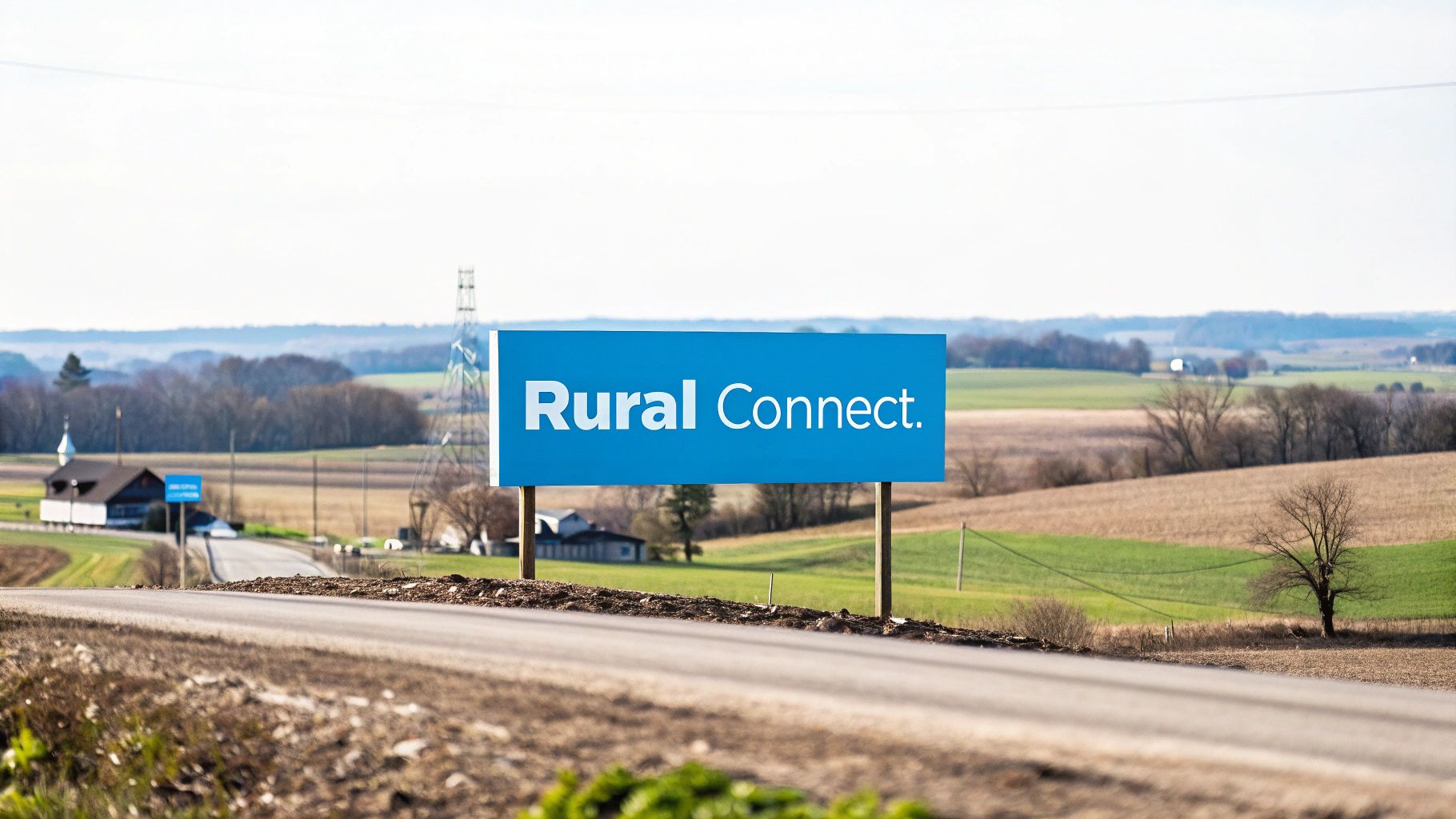

· By James
How to Get Internet in Rural Areas: 5 Easy Tips
Navigating the Rural Internet Challenge
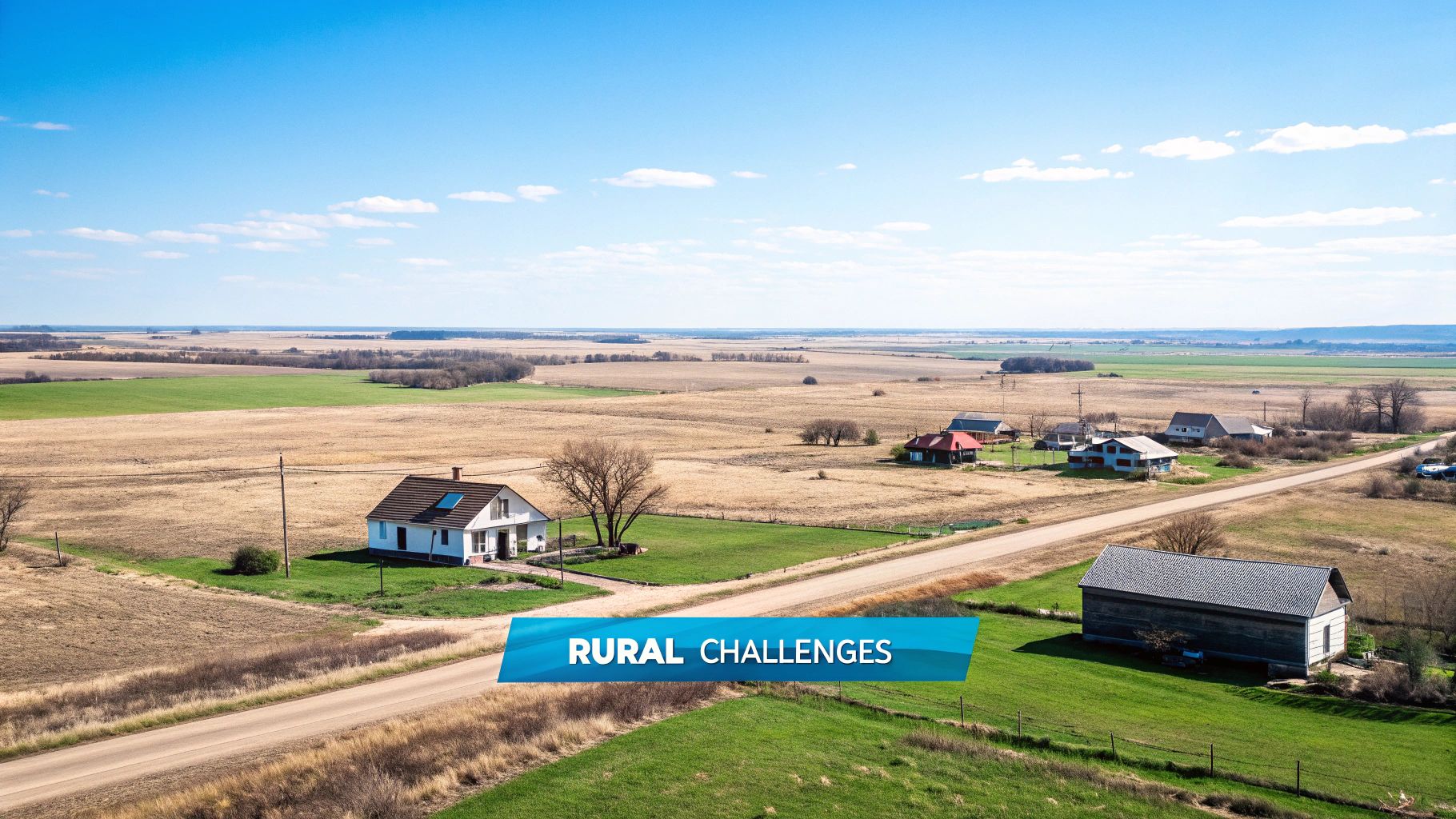
Getting a reliable internet connection in rural areas comes with its own set of obstacles. Unlike bustling city centers, the cost of bringing internet service to sparsely populated areas often discourages investment from large providers. This is mainly because setting up and maintaining infrastructure over long distances is expensive.
Think about laying fiber optic cables or erecting cell towers for a handful of homes. It’s simply not as profitable as doing the same in a densely populated city. This difference creates a digital divide, impacting millions who can't access the opportunities that reliable internet offers.
Understanding the Barriers to Rural Connectivity
Distance and terrain are major roadblocks to bringing internet access to rural locations. Mountainous landscapes, thick forests, and vast distances complicate signal delivery and increase installation costs. Fewer potential customers also contribute to the problem.
Lower population density means there are fewer people to share the cost of building new infrastructure. This makes projects less attractive to commercial providers looking for a strong return on their investment. It's clear that just extending urban internet solutions to rural areas isn't a practical approach.
Providing internet access in rural areas isn't just a national issue; it's a worldwide concern. As of 2024, only about 48 percent of people in rural areas globally have internet access, compared to roughly 83 percent in urban areas. The difference is even greater in certain regions like Africa, where only 23 percent of the rural population is online. This limited access underscores the need for new and focused solutions. More detailed statistics can be found here: https://www.statista.com/statistics/1229532/internet-access-rate-worldwide-urban-rural-by-market-maturity/
Turning Challenges into Opportunities
Many rural communities are turning these challenges into opportunities for progress. They're exploring options like satellite internet, fixed wireless, and community-owned networks. By understanding their unique needs and limitations, these communities are finding solutions that truly work.
This local approach, combined with an openness to new technologies, is helping bridge the digital divide and bring reliable, affordable internet to everyone. Figuring out your specific situation is the first step toward finding the right internet solution for your rural property.
Satellite Internet: The Sky-Based Solution
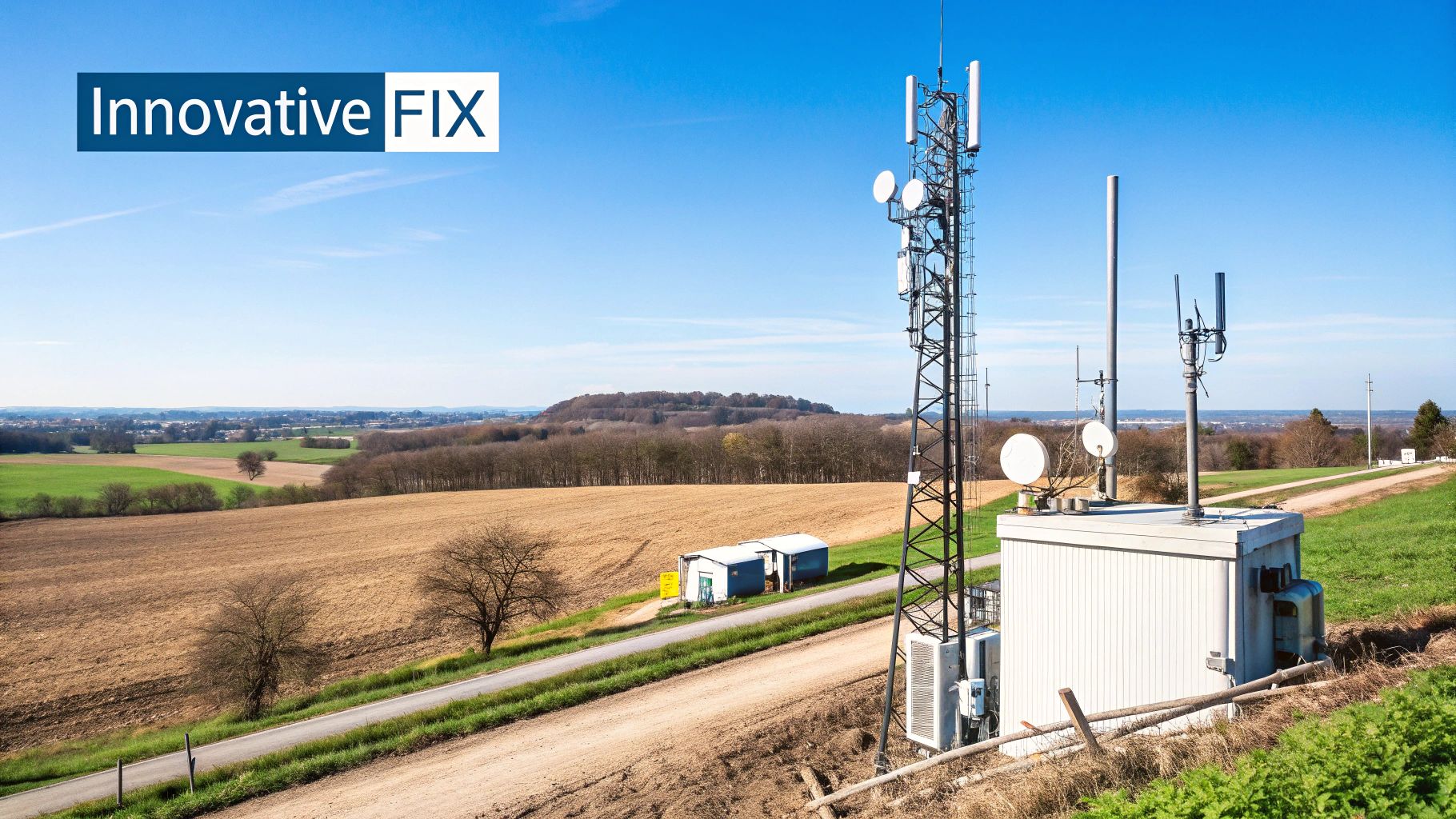
For those in remote areas, satellite internet often provides the only connection to the online world. From older geostationary satellites to newer low-Earth orbit (LEO) constellations, the technology has evolved. Understanding the nuances of satellite internet is key for informed decisions about rural connectivity.
Comparing Satellite Internet Providers
Several providers lead the satellite internet market. Each has its pros and cons. Starlink, known for its LEO network, aims for higher speeds and lower latency than traditional services. Viasat and HughesNet are established, offering wider availability, often with lower speeds and higher latency.
To help you compare, we've compiled a table summarizing key features of these providers:
To help compare providers, here’s a table summarizing key features:
Satellite Internet Provider Comparison: A comprehensive comparison of major satellite internet providers available for rural areas
| Provider | Speed Range | Latency | Data Caps | Installation Cost | Monthly Cost | Best For |
|---|---|---|---|---|---|---|
| Starlink | 50-200 Mbps | 20-40 ms | Varies | $599 | $110+ | Speed and low latency |
| Viasat | 12-100 Mbps | 550-650 ms | Varies | $99-$299 | $50+ | Wide availability |
| HughesNet | 25 Mbps | 700+ ms | Varies | $99-$499 | $64.99+ | Budget-conscious users |
Note: Pricing and data caps can vary depending on your specific plan and location. Always check with the provider for the most up-to-date information.
Choosing the right provider hinges on your individual needs and where you live. Look beyond marketing and research real-world performance and user experiences.
Practical Considerations For Satellite Internet
Satellite internet can connect almost any location. However, there are practical factors to consider. Installation can be tricky, especially in wooded areas needing a clear view of the sky. Weather can also affect performance.
Heavy rain or snow can disrupt the signal. Even cloud cover can sometimes impact speed. Relying solely on satellite internet may not be ideal for consistently high performance. Combining satellite with other technologies, like fixed wireless, can create a more robust system.
The Cost of Connectivity: Satellite Vs. Other Options
Satellite internet requires investment. Equipment costs, installation, and monthly fees can be higher than alternatives, if any exist. Understand the long-term costs for a sound financial decision.
Weigh the benefits of satellite against potential costs. Sometimes, mobile broadband or fixed wireless might be more cost-effective with decent performance. The digital divide is a real challenge. Even with advances, disparities remain. Globally, about 5.5 billion people were online in 2024. This leaves roughly one-third offline, mostly in rural and low-income regions. Learn more here: https://etradeforall.org/news/global-internet-use-continues-to-rise-but-disparities-remain-especially-in-low-income-regions. This shows the ongoing need for better rural infrastructure for equal access. Evaluate your needs, location, and budget to find the best path to reliable internet access.
Fixed Wireless: Bridging the Last Mile
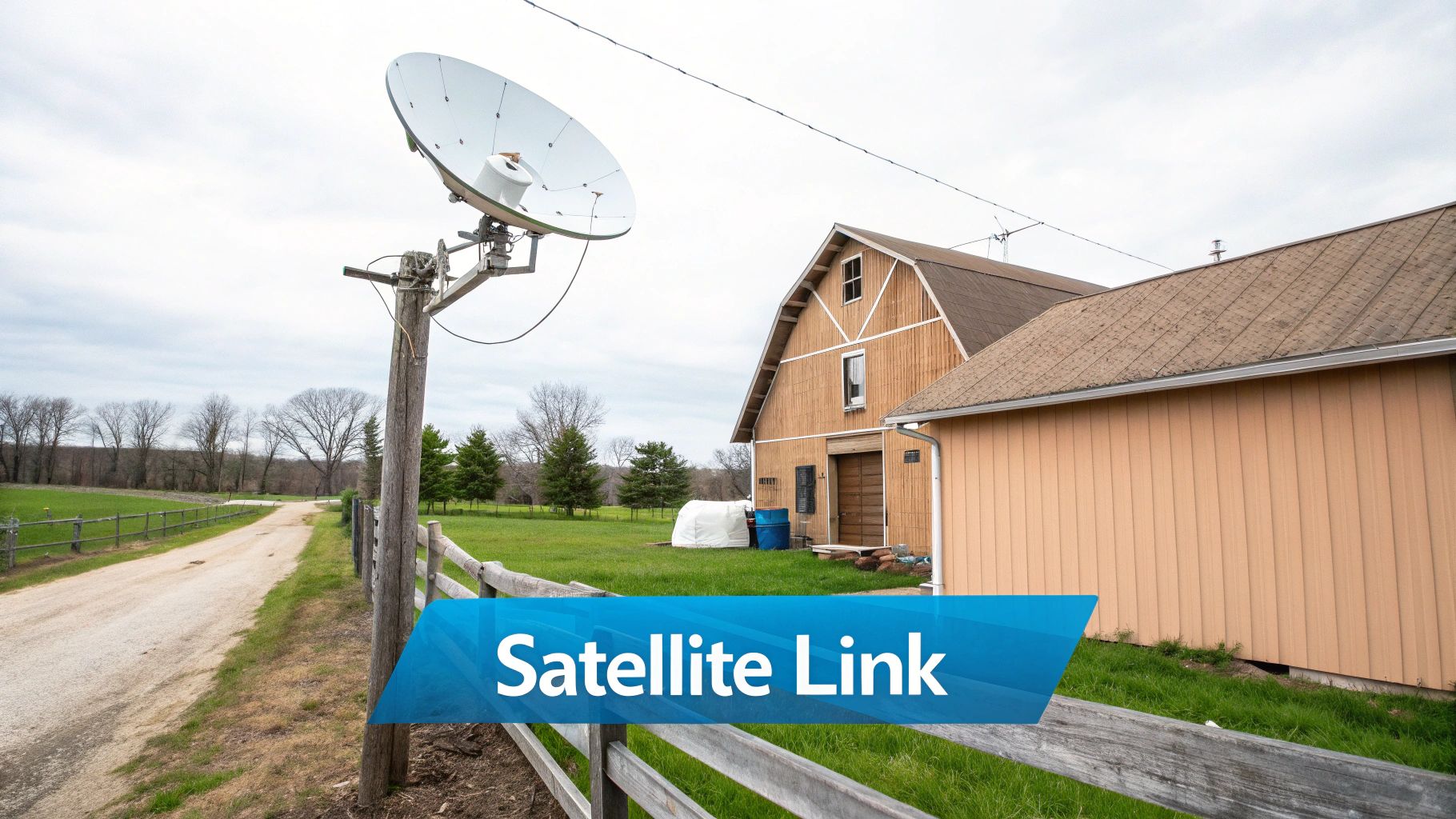
Fixed wireless internet offers a compelling solution for rural connectivity. It bridges the gap where traditional wired connections are impractical. This technology transmits broadband signals wirelessly, covering long distances. This makes it a viable option where laying physical cables is cost-prohibitive or simply impossible. For many rural households, fixed wireless is a lifeline to online access.
How Fixed Wireless Works
Fixed wireless internet relies on a network of towers and receivers. A Wireless Internet Service Provider (WISP) transmits a signal from a tower to a receiver installed at your home. This receiver, often mounted on the roof, converts the signal into usable internet. Think of it as a dedicated, localized cell tower serving your property.
This technology bypasses the need for extensive ground-level wiring. This makes it particularly well-suited for areas with challenging terrain or low population density. The "last mile" challenge, connecting individual homes to the main internet infrastructure, is addressed by fixed wireless's direct line-of-sight approach.
Assessing Your Location For Fixed Wireless
Several factors influence whether fixed wireless is a good choice for your rural location. Line of sight is crucial. The receiver needs an unobstructed view of the WISP's tower. Obstacles like trees, hills, or buildings can interfere with the signal. A higher elevation can be beneficial, providing a clearer line of sight.
The distance to the nearest tower also impacts signal strength and speed. Greater distances can result in slower speeds. Carefully considering these geographical factors will help you assess your property's suitability for fixed wireless internet.
Key Questions To Ask Your WISP
Before choosing a fixed wireless provider, it's essential to ask detailed questions. Inquire about typical speeds during peak hours, not just the advertised maximums. Latency, the delay in data transmission, affects activities like online gaming and video conferencing, so be sure to ask about that as well.
Find out how weather impacts the service. Heavy rain or snow can sometimes disrupt wireless signals. Understanding the service level agreement and any data caps is also important. These answers will give you a realistic expectation of the service. For example, a company like SwiftNet Wifi might specialize in rural high-speed internet.
Optimizing Your Fixed Wireless Connection
Rural residents using fixed wireless often share tips for optimization. Proper receiver placement is key. Higher locations generally provide a better line of sight. Weatherproofing the equipment is also important to protect it and ensure consistent performance.
Regularly check for obstructions like overgrown trees. Using signal boosters can amplify weak signals, improving speed and reliability. These strategies can significantly enhance the performance and longevity of your connection. This is particularly vital in areas with limited digital access. For example, in Latin America and the Caribbean, approximately 77 million rural residents lack high-quality internet access (https://www.iadb.org/en/news/least-77-million-rural-inhabitants-have-no-access-high-quality-internet-services). By exploring these options and asking the right questions, you can find a reliable internet solution for your rural needs.
Mobile Broadband: Harnessing Cellular Networks
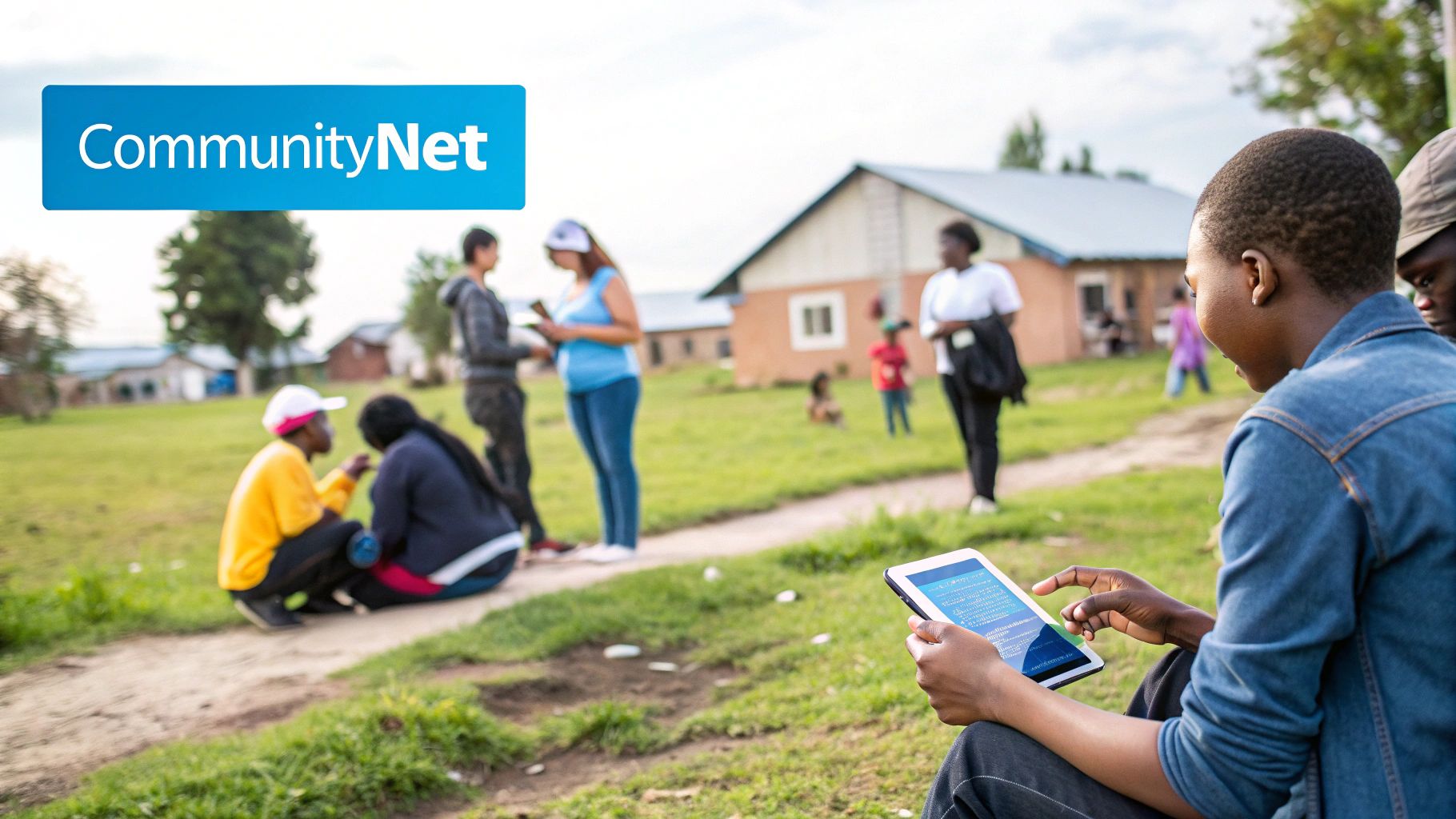
Cellular networks have evolved beyond simple phone calls. They now offer practical internet access for rural homes, especially with the rise of 4G LTE and 5G technologies. This opens up online connectivity even in areas lacking traditional wired internet. This section explores using cellular connectivity as your primary internet source.
Rural LTE/5G Plans and Hotspot Optimization
Many cellular carriers provide data plans specifically for rural customers. These plans typically include larger data allowances to meet the needs of households relying entirely on cellular internet. Optimizing your hotspot performance is also crucial.
Factors like the hotspot device itself, its location in your home, and even an external antenna can significantly affect speed and reliability. Many rural internet users boost weak signals by strategically choosing equipment and finding the best spot for their devices. This can drastically improve your browsing and streaming quality.
Carrier Coverage and Signal Assessment
Carrier coverage maps can be deceptive. While they often show broad coverage, the reality on the ground may differ. Understanding the actual differences between carriers in your specific location is essential.
Before choosing a plan, research coverage by speaking with neighbors and testing signal strength at your home. Several apps and websites can help you gauge signal quality. This ensures you have accurate data about download and upload speeds before making a decision.
Managing Data and Maximizing Usage
Many rural cellular plans still have data caps. Managing your data usage is crucial for avoiding extra charges. Several tools can help you track your internet consumption.
Knowing your data usage helps you prioritize and implement data-saving strategies. Compression technologies and scheduling data-intensive tasks, like downloads or backups, during off-peak hours can help extend your data allowance. Being mindful of your usage helps maximize your internet access within your budget. Services like SwiftNet Wifi specialize in providing high-speed 5G internet to rural areas and RV travelers, often offering solutions for data management challenges. This targeted approach helps bridge the digital divide and brings reliable, affordable internet to those often overlooked by traditional providers.
Traditional Connections: When Wired Options Work
While the latest wireless technologies often grab the headlines, don't overlook the enduring value of wired connections like DSL (Digital Subscriber Line). For many rural communities, DSL remains a practical option, offering surprisingly dependable internet access, especially with proper optimization. Let's explore how DSL and other wired solutions can effectively meet rural connectivity needs.
Determining Service Availability and Line Quality
Before committing to any internet technology, it's essential to understand what services are available at your specific location. For DSL, this involves checking with your local telephone company to confirm whether your home is within their service area. This "serviceable range" is a fundamental requirement for wired internet.
Next, evaluate the line quality. The physical condition of the copper lines linking your home to the provider directly affects your internet speed and stability. Older or poorly maintained lines can significantly impact performance. A clear understanding of the existing infrastructure is crucial.
Maximizing Existing Lines With the Right Equipment
The right equipment can significantly enhance your internet connection speed. A high-quality modem and router) designed for DSL can noticeably boost performance. This equipment acts as a bridge between your devices and the internet signal carried over the phone lines. Investing in a modem with bonding technology, which combines multiple DSL lines for increased speed, can be particularly advantageous.
Pushing Providers For Infrastructure Improvements
While individual equipment upgrades are helpful, sometimes the bottleneck lies within the provider's infrastructure. If you consistently experience slow speeds or reliability issues, contact your provider and advocate for improvements. This advocacy can include requesting upgrades to current lines or extending higher-speed services to underserved areas.
Collective action within rural communities can be especially powerful in driving change. Many rural residents have achieved better internet service through community initiatives. For instance, some communities have successfully pushed for faster speeds through programs like the Broadband Equity Access and Deployment (BEAD) program, which aims to bring high-speed internet to underserved areas, especially in rural locations.
Combining Traditional With Modern Technologies: Hybrid Solutions
DSL and other wired connections can often be paired with newer technologies to create a hybrid internet system. Using DSL as your primary connection and supplementing it with mobile broadband as a backup can provide a dependable and robust internet solution. This flexible approach addresses the limitations of older technologies by incorporating the strengths of newer options.
Troubleshooting and Negotiating For Better Service
Even with an optimized system, occasional problems might arise. Knowing basic troubleshooting steps, like checking for line interference or resetting your modem, can quickly restore your connection.
Don't hesitate to negotiate with your provider for better service or pricing. Many providers offer promotions or discounts that can lower your monthly bill. Proactive management of your internet service can lead to higher satisfaction and cost savings. Combining these strategies with community action is often the key for rural residents to overcome connectivity challenges and fully access the online world.
Community Power: Collective Connectivity Solutions
When commercial internet providers leave gaps in their service, rural communities are taking connectivity into their own hands. This movement involves a variety of resident-led approaches, including rural broadband cooperatives, municipal networks, and community mesh systems. These initiatives showcase the potential of collective action to close the digital divide.
Exploring Community-Driven Internet
Rural broadband cooperatives function similarly to traditional utility cooperatives. They bring high-speed internet to underserved areas through community ownership and shared investment. Municipal networks offer another solution where the local government builds and manages its own internet infrastructure, ensuring equal access for all residents. For example, several Utah towns have successfully launched municipal networks providing affordable and reliable service. Community mesh systems, built and managed by residents, create a network by wirelessly sharing connections from one house to the next. This provides an alternative to relying entirely on large providers.
Let's compare these different options in more detail:
To help you understand the various options available, here's a comparison table outlining the pros and cons of each technology:
Rural Internet Access Options Comparison
An overview of different internet technologies available for rural areas with their typical characteristics
| Technology | Typical Speeds | Reliability | Setup Complexity | Cost Range | Geographic Limitations |
|---|---|---|---|---|---|
| Rural Broadband Cooperatives | Comparable to commercial providers | Generally reliable | Moderate, requires community organization | Varies depending on build-out costs | Limited to the cooperative's service area |
| Municipal Networks | High speeds, often fiber optic | Typically very reliable | High, requires significant capital investment | Can be lower cost due to public funding | Limited to the municipality's boundaries |
| Community Mesh Systems | Lower speeds, dependent on individual connections | Can be less reliable, susceptible to interference | Low, resident-led setup | Low cost, often based on shared equipment | Range limited by wireless signal strength |
This table summarizes the key characteristics of each technology, allowing communities to choose the best fit for their specific circumstances. The choice often depends on factors like population density, available funding, and technical expertise within the community.
Organizing a Community Connectivity Project
Starting a community-led internet project involves several key steps. First, organize community meetings to assess the specific needs and explore potential solutions. Next, identify possible funding sources, such as grants, loans, and community contributions. Choosing the right technology is crucial, and this decision depends on the community's needs and geographical landscape. Options might include fixed wireless, fiber optic, or a hybrid approach.
Navigating Regulations and Overcoming Challenges
Community-driven projects sometimes face regulatory hurdles. A strong understanding of local and national broadband regulations is vital for successful implementation. Obtaining necessary permits and licenses can be a time-consuming process. Some community groups have even faced legal challenges from existing providers contesting their right to establish independent networks. However, many successful initiatives have overcome these challenges by building strong community support and working collaboratively with regulatory bodies.
Resources and Strategies For Success
Numerous resources exist to help rural communities build their own internet solutions. The Institute for Local Self-Reliance (ILSR) offers guidance and support for community-based broadband projects. They provide helpful tools, funding resources, and partnership strategies proven effective in other communities. In addition, the federal government offers funding programs designed specifically for rural broadband development.
Turning a digitally underserved rural community into a connected hub requires thoughtful planning, consistent effort, and community involvement. By acknowledging potential obstacles and using available resources, rural areas can gain control of their internet access and create a brighter digital future. This is essential as reliable internet becomes increasingly crucial for economic growth, education, healthcare, and civic participation.
Your Rural Connectivity Action Plan
Securing reliable internet access for your rural property demands a well-structured plan. This guide will walk you through assessing your needs and exploring the available options.
Assessing Your Connectivity Needs and Location
First, determine your internet usage requirements. Think about how you'll primarily use the internet. Will you be streaming movies on Netflix, working remotely, or just browsing? This will help you determine the required speed and data allowance.
Next, consider your property's physical characteristics. Are there trees blocking the line of sight to the sky? What's the distance to the closest town? This is vital for determining the feasibility of various internet technologies.
Researching Available Internet Options
Compile a list of potential internet providers. This could include satellite internet companies like Starlink, fixed wireless providers, cellular carriers such as Verizon and AT&T, and even traditional DSL providers. Reach out to each provider to gather detailed information about their plans, pricing, and expected performance.
Don't rely solely on advertised speeds. Ask about actual performance during peak usage times. Compare data caps, latency, and contract terms. Thorough research will help you narrow down the best choices.
Building a Resilient System: Combining Technologies
Many rural internet users successfully combine different technologies. For example, they might use fixed wireless as their primary connection and have a mobile hotspot for backup during outages.
This hybrid approach builds a more resilient connection, ensuring consistent access even if one service has issues. This is a practical solution to overcome the limitations of single technologies.
Testing and Negotiating Before Committing
Before signing any long-term contracts, test the chosen solution if possible. Many providers have trial periods. This lets you experience the service and assess its suitability.
After finding a good option, negotiate with the provider. Ask about promotions, discounts, or flexible contract terms. This could potentially reduce costs or get you a better deal.
Troubleshooting and Adapting to Change
Even with careful planning, you might encounter occasional connection problems. Learn some basic troubleshooting steps. These might include restarting your equipment, checking for signal interference, or calling customer support.
The rural internet landscape is continuously evolving. New technologies and providers appear regularly. Keep up-to-date on the latest developments and be prepared to adapt your setup if needed. This will help you maintain access to the best internet solution for your rural location.
For a high-speed 5G internet option specifically designed for rural areas and RV travelers, consider SwiftNet Wifi. Learn more about SwiftNet Wifi's plans and coverage options.

